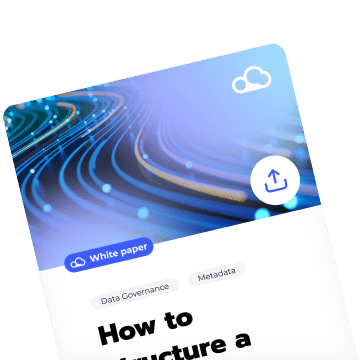While “data governance” and “information governance” are often used interchangeably, they represent different, but overlapping, concepts in the realm of data management. It’s important to understand the distinction between these two terms to implement effective strategies in your organization, as both these practices have unique goals, processes, and values that they bring to any organization.
Understanding data governance
Many people are wondering, “What is data governance?” Data governance refers to the formal management of data to ensure its availability, usability, integrity, and security within an enterprise. It’s a structured process that ensures that the data is trustworthy, reliable, and consistent, making it a critical part of any organization’s data management strategy.
Specifically, data governance involves setting up formal procedures and rules that guide the collection, storage, use, and disposal of data. These procedures and rules are often defined by a governing body within the organization and implemented with the help of various data stewards scattered throughout the organization. The key aspects that data governance rules cover include data integrity, security, privacy, and compliance. In essence, data governance ensures that data is treated as a valuable asset, properly maintained, protected, and used effectively to support business decisions and operations.
To implement data governance effectively, organizations must first identify their key data elements, often known as critical data elements (CDEs), which could include things like customer data, financial data, or operational data. Then, policies and procedures are developed around how these CDEs should be handled. Furthermore, roles and responsibilities are defined, such as who is responsible for data quality, who can access certain data, and who decides on changes to data definitions.
Understanding information governance
Information governance, while similar to data governance in many ways, is broader in scope. It pertains to the framework used to manage information at an enterprise level, which includes ensuring regulatory compliance, mitigating risks, and aiding strategic decisions. Importantly, information governance is not limited to structured data; it also covers unstructured information like emails, documents, images, and more.
The goal of information governance is to manage and use the organization’s information in a way that effectively supports its objectives. It involves the coordination of various disciplines, including legal, privacy, information technology, risk management, business operations, and others. It aims to control information risks, particularly legal and security risks while enabling and enhancing business operations that use information.
Implementing information governance involves creating and maintaining policies, procedures, and controls that dictate how information is handled. This includes how information is created, used, stored, archived, and ultimately destroyed. These rules and processes should comply with all relevant laws and regulations, protect the organization’s intellectual property, ensure privacy, and facilitate the efficient and effective use of information to achieve the organization’s goals.
Key differences: Scope & approach
While both information governance vs. data governance are essential components of an effective data management strategy, the primary difference between the two lies in their scope and approach. Data governance has a narrower focus, primarily dealing with the technical aspects of managing structured data assets within an organization. Its main objective is to ensure the quality, accuracy, consistency, and security of data, making it a foundational component of data management.
On the other hand, information governance takes a broader view. It encompasses all information an organization possesses, not just structured data. This includes all forms of information, both digital and physical. The scope of information governance extends to the operational, legal, and compliance aspects of information management. Its primary goal is to minimize risks associated with information, ensure regulatory compliance, and support the organization’s operational requirements.
While data governance sets the rules and processes for managing data, information governance focuses on the policies and practices needed to manage broader information assets, including unstructured data. It includes elements of data governance but also encompasses other areas such as information security, information privacy, information lifecycle management, information risk management, and regulatory compliance.
How they work together
Data governance and information governance, despite their differences, are not mutually exclusive; they represent two parts of a holistic approach to managing an organization’s data and information assets. Data governance can be viewed as a component of the broader information governance framework, focusing on the management of structured data.
In essence, data governance provides the groundwork on which effective information governance is built. By ensuring the quality, reliability, and security of structured data, data governance supports the larger goals of information governance. These might include compliance with legal and regulatory requirements, risk mitigation, and operational efficiency. Thus, a strong data governance framework can enhance the effectiveness of information governance by ensuring that high-quality data underpins decision-making, business processes, and strategic initiatives.
Which one does your organization need?
When it comes to deciding between data governance and information governance, it’s not a matter of choosing one over the other but understanding how they each fit into your organization’s overall data and information management strategy. A robust data governance framework may be crucial if your organization heavily relies on structured data for decision-making and business operations.
However, if your organization deals with a diverse mix of structured and unstructured data, and faces a variety of legal, compliance, and operational challenges, a more comprehensive information governance strategy may be required. This approach will ensure not just the proper management of structured data but also the efficient, secure, and complaint handling of all types of information.
Essentially, the right choice depends on the specific data and information landscape of your organization and the industry in which it operates. Implementing both data and information governance can help organizations realize the full potential of their information assets and navigate the increasing complexity of the information age.
Implementing both in your organization
To truly maximize the value of your data and information assets, it’s recommended to implement both data and information governance in your organization. This involves defining clear policies, roles, and responsibilities, implementing the right tools and technologies, and fostering a culture that values data and information as critical business assets.
Understanding the nuances between data governance and information governance allows you to make more informed decisions about your governance strategies and helps you unlock the true value of your information assets.
Discover personalized metadata management and data governance – Turn to DataGalaxy to create your company’s data lineage mapping, develop a standardized business glossary, and much more! Check our calendar and select a date that works for you. Request a demo today!





